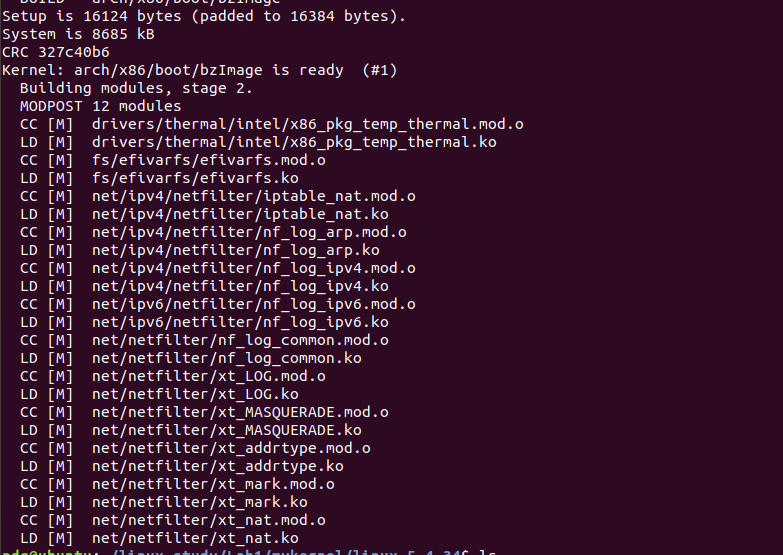一、升级Vmware Workstation Pro
由于原来使用的Vmware Workstation Pro是12.0,不支持ubuntu18.04的linux版本内核,所以要进行升级
从官网下载和电脑操作系统对应的Vmware Workstation Pro15版本,然后按照提示进行就OK了,中间需要重启一次
最后要填入一个激活码才能永久使用,这个网上一搜有一堆,随便试了一个就OK了。。。
最终环境是:Vmware Workstation Pro15.5 + Ununtu18.04 LTS
二、为 mykernel2.0 配置开发环境
git clone https://github.com/mengning/mykernel sudo apt install axel axel -n -20 https://mirrors.edge.kernel.org/pub/linux/kernel/v5.x/linux-5.4.34.tar.xz xz -d linux-5.4.34.tar.xz tar -xvf linux-5.4.34.tar cd linux-5.4.34 patch -p1 < ../mykernel-2.0_for_linux-5.4.34.patch sudo apt install build-essential gcc-multilib sudo apt install libncurses5-dev bison flex libssl-dev libelf-dev sudo apt install qemu # install QEMU
三、然后对内核进行编译,并且从QEMU窗口中观察my_start_kernel的执行
make defconfig make -j$(nproc) #这里大概编译了20分钟 qemu-system-x86_64 -kernel arch/x86/boot/bzImage
编译完成结果如下所示:

如下所示,从QEMU窗口中可以看到my_start_kernel在执行,同时my_timer_handler时钟中断处理程序周期性执行

四、完成一个可运行的小OSkernel
参考:https://github.com/mengning/mykernel
1、首先在mykernel目录下增加一个mypcb.h头文件,用来定义进程控制块。也就是进程结构体的定义,在Linux内核中是struct tast_struct结构体。
操作系统进程控制块中包含的信息有:
- 进程描述信息:PID,进程标识符用于唯一的标识一个进程。
- 进程控制信息:进程当前状态、进程优先级、程序开始地址、各种计时信息、通信信息、
- 资源信息:占用内存大小及管理用数据结构指针、交换区相关信息、I/O设备号、缓冲、设备相关的数结构、文件系统相关指针
- 现场保护信息(cpu进行进程切换时):寄存器、PC、程序状态字PSW、栈指针
这里对PCB进行了简化,只保留我们所能用到的信息即可;
1 /* 2 * linux/mykernel/mypcb.h 3 * Kernel internal PCB type 4 */ 5 6 #define MAX_TASK_NUM 4 7 #define KERNEL_STACK_SIZE 1024*2 8 /* CPU-specific state of this task */ 9 10 //存储ip和sp 11 struct Thread { 12 unsigned long ip; //函数入口指针 13 unsigned long sp; //栈顶指针 14 }; 15 16 //PCB结构 17 typedef struct PCB{ 18 int pid;//进程id 19 volatile long state; /* -1 unrunnable, 0 runnable, >0 stopped */ 20 unsigned long stack[KERNEL_STACK_SIZE];//进程堆栈 21 /* CPU-specific state of this task */ 22 struct Thread thread;//线程 23 unsigned long task_entry;//进程入口地址 24 struct PCB *next;//下一个进程控制块地址 25 }tPCB; 26 27 void my_schedule(void);//调度函数
2、对mymain.c进⾏修改,这⾥是mykernel内核代码的⼊⼝,负责初始化内核的各个组成部分。在Linux内核源代码中,实际的内核⼊⼝是init/main.c中的start_kernel(void)函数。
1 /* 2 * linux/mykernel/mymain.c 3 * Kernel internal my_start_kernel 4 */ 5 #include <linux/types.h> 6 #include <linux/string.h> 7 #include <linux/ctype.h> 8 #include <linux/tty.h> 9 #include <linux/vmalloc.h> 10 11 12 #include "mypcb.h" 13 14 tPCB task[MAX_TASK_NUM]; 15 tPCB * my_current_task = NULL; 16 volatile int my_need_sched = 0; 17 18 void my_process(void);//模拟进程执行代码 19 20 21 void __init my_start_kernel(void) 22 { 23 int pid = 0;//0号进程 24 int i; 25 /* 初始化0号进程PCB信息*/ 26 task[pid].pid = pid; 27 task[pid].state = 0;/* -1 unrunnable, 0 runnable, >0 stopped */ 28 //任务入口地址,将my_process的地址赋给ip 29 task[pid].task_entry = task[pid].thread.ip = (unsigned long)my_process; 30 //0号进程PCB堆栈栈顶地址赋给sp 31 task[pid].thread.sp = (unsigned long)&task[pid].stack[KERNEL_STACK_SIZE-1]; 32 //系统刚开始只有一个进程,下一个进程地址指向自身 33 task[pid].next = &task[pid]; 34 /*fork more process */ 35 //复制0号进程创建更多进程,并对它们赋值,插入队列 36 for(i=1;i<MAX_TASK_NUM;i++) 37 { 38 memcpy(&task[i],&task[0],sizeof(tPCB)); 39 task[i].pid = i; 40 task[i].thread.sp = (unsigned long)(&task[i].stack[KERNEL_STACK_SIZE-1]); 41 task[i].next = task[i-1].next; 42 task[i-1].next = &task[i]; 43 } 44 /* start process 0 by task[0] */ 45 //启动0号任务,开始执行0号进程 46 pid = 0; 47 my_current_task = &task[pid];//当前任务指针 48 49 /*下面这一段是进程执行的关键汇编代码,下文会对其进行详细分析 50 * %1指task[pid].thread.sp,%0指task[pid].thread.ip 51 */ 52 asm volatile( 53 "movq %1,%%rsp " /* set task[pid].thread.sp to rsp */ 54 "pushq %1 " /* push rbp */ 55 "pushq %0 " /* push task[pid].thread.ip */ 56 "ret " /* pop task[pid].thread.ip to rip */ 57 : 58 : "c" (task[pid].thread.ip),"d" (task[pid].thread.sp) /* input c or d mean %ecx/%edx*/ 59 ); 60 } 61 62 int i = 0; 63 64 //模拟进程执行过程,这⾥采⽤的是进程运⾏完⼀个时间⽚后主动让出CPU的⽅式。 65 void my_process(void) 66 { 67 while(1) 68 { 69 i++; 70 if(i%10000000 == 0) 71 { 72 printk(KERN_NOTICE "this is process %d - ",my_current_task->pid); 73 if(my_need_sched == 1)//判断是否需要调度 74 { 75 my_need_sched = 0; 76 my_schedule();//执行调度 77 } 78 printk(KERN_NOTICE "this is process %d + ",my_current_task->pid); 79 } 80 } 81
3、进程运⾏过程中是怎么知道时间⽚消耗完了呢?这就需要时钟中断处理过程中记录时间⽚。
1 /* 2 * Called by timer interrupt. 3 * it runs in the name of current running process, 4 * so it use kernel stack of current running process 5 */ 6 void my_timer_handler(void) 7 { 8 if(time_count%1000 == 0 && my_need_sched != 1)//设置时间片的大小,时间片用完则开始调度 9 { 10 printk(KERN_NOTICE ">>>my_timer_handler here<<< "); 11 my_need_sched = 1;//设置进程调度标志 12 } 13 time_count ++ ; 14 return; 15 } 16 17 //调度函数 18 void my_schedule(void) 19 { 20 tPCB * next;//下一个进程指针 21 tPCB * prev;//当前进程指针 22 23 if(my_current_task == NULL 24 || my_current_task->next == NULL) 25 { 26 return; 27 } 28 printk(KERN_NOTICE ">>>my_schedule<<< "); 29 /* schedule */ 30 next = my_current_task->next;//下一个进程 31 prev = my_current_task;//当前进程 32 if(next->state == 0)/* -1 unrunnable, 0 runnable, >0 stopped */ 33 { 34 my_current_task = next; //排队策略 35 printk(KERN_NOTICE ">>>switch %d to %d<<< ",prev->pid,next->pid); 36 /* 进程切换 */ 37 //下面是进程切换的汇编代码,下文将进行详细分析 38 asm volatile( 39 "pushq %%rbp " /* save rbp of prev */ 40 "movq %%rsp,%0 " /* save rsp of prev */ 41 "movq %2,%%rsp " /* restore rsp of next */ 42 "movq $1f,%1 " /* save rip of prev */ 43 "pushq %3 " 44 "ret " /* restore rip of next */ 45 "1: " /* next process start here */ 46 "popq %%rbp " 47 : "=m" (prev->thread.sp),"=m" (prev->thread.ip) 48 : "m" (next->thread.sp),"m" (next->thread.ip) 49 ); 50 } 51 return; 52 }
五、关键汇编代码分析
1、启动执⾏第⼀个进程的关键汇编代码
%1是指后⾯的task[pid].thread.sp,%0是指后⾯的task[pid]. thread.ip
1 asm volatile( 2 "movq %1,%%rsp " /* 将进程原堆栈栈顶的地址存⼊RSP寄存器 */ 3 "pushq %1 " /* 将当前RBP寄存器值压栈 */ 4 "pushq %0 " /* 将当前进程的RIP压栈 */ 5 "ret " /* ret命令正好可以让压栈的进程RIP保存到RIP寄存器中 */ 6 : 7 : "c" (task[pid].thread.ip),"d" (task[pid].thread.sp) 8 );
这一段代码用于启动0号进程:
movq %1,%%rsp #将rsp寄存器指向进程0的堆栈栈底,task[pid].thread.sp的初始值就是堆栈栈底;
pushq %1 #将当前rsp寄存器的值压栈,rsp=rsp-8;
pushq %0 #将当前进程的rip入栈,相应的rsp寄存器指向的位置也发生了变化。rsp=rsp-8;
ret #将栈顶位置task[0]. thread.ip,也就是my_process(void)函数的地址放入rip寄存器,rsp=rsp+8;
这样就完成了进程0的启动,开始执行my_process(void)函数的代码
2、进程切换关键代码分析
%0指pre->thread.sp, %1指prev->thread.ip
%2指next->thread.sp,%3指next->thread.ip
1 asm volatile( 2 "pushq %%rbp " /* save rbp of prev */ 3 "movq %%rsp,%0 " /* save rsp of prev */ 4 "movq %2,%%rsp " /* restore rsp of next */ 5 "movq $1f,%1 " /* save rip of prev */ 6 "pushq %3 " 7 "ret " /* restore rip of next */ 8 "1: " /* next process start here */ 9 "popq %%rbp " 10 : "=m" (prev->thread.sp),"=m" (prev->thread.ip) 11 : "m" (next->thread.sp),"m" (next->thread.ip) 12 );
为了简便,假设系统只有两个进程,分别是进程0和进程1。进程0由内核启动时初始化执⾏,然后需要进程调度和进程切换,然后开始执⾏进程1。
进程切换过程中进程0和进程1的堆栈和相关寄存器的变化过程⼤致如下:
pushq %%rbp #保存prev进程的rbp的值,入栈
movq %%rsp,%0 #当前rsp寄存器的值到prev->thread.sp,这时rsp寄存器指向进程的栈顶地址,也就是保存prev进程栈顶地址
movq %2,%%rsp #将next进程的栈顶地址放入rsp寄存器,完成进程0和进程1的堆栈切换
movq $1f,%1 #保存prev进程当前rip寄存器的值到prev->thread.ip,$1f指标号1
pushq %3 #把即将执行的next进程的指令地址next->thread.ip入栈
ret #将压入栈的next->thread.ip放入rip寄存器
1: #标号1是一个特殊的地址位置,地址是$1f
popq %%rbp #将next进程堆栈基地址从堆栈恢复到rbp寄存器中
六 、结果演示
完成代码修改,重新编译运行
我们可以看到进程0切换到进程1

七、小结
通过这次实验,我对linux进程启动和调度切换有了更加深刻的理解,并且实现mykernel,对进程的实现细节和进程切换的底层堆栈变化有了更深的了解。总之,受益匪浅。